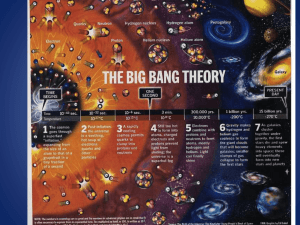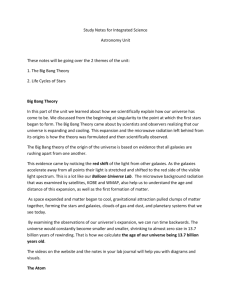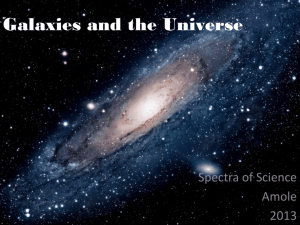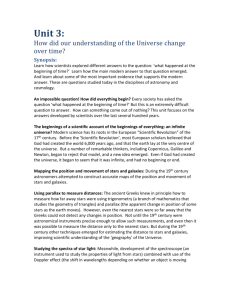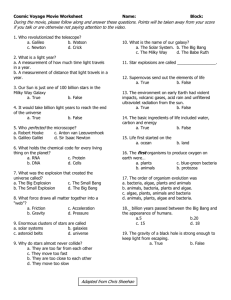ESChap31GalaxyUniverse
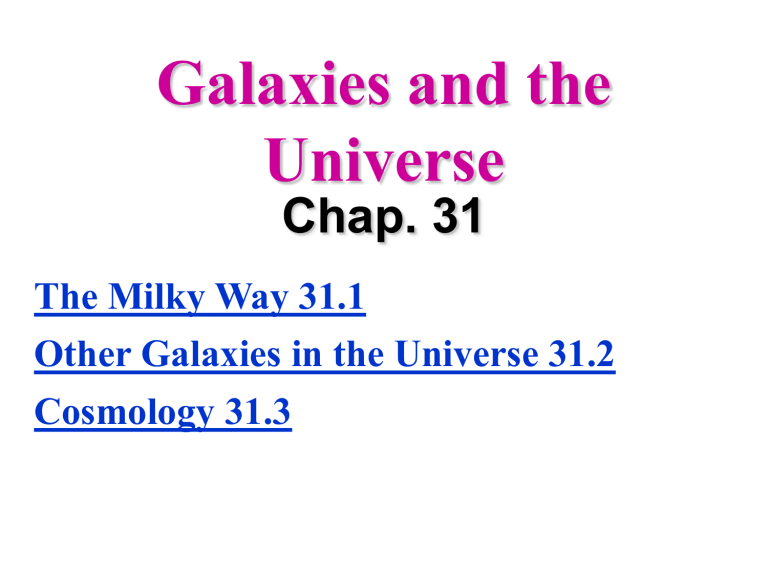
Galaxies and the
Universe
Chap. 31
The Milky Way 31.1
Other Galaxies in the Universe 31.2
Cosmology 31.3
The Milky Way
Objectives
• determine the size and shape of the
Milky Way, as well as Earth’s location within it.
• describe how the
Milky Way formed.
I. Discovering the Milky Way
A. Distances to clusters determined using variable stars.
I. Discovering the Milky Way
A. Distances to clusters determined using variable stars.
Variable Stars
Stars in the ‘giant’ branch of
HR diagram that pulsate in brightness
I. Discovering the Milky Way
A. Distances to clusters determined using variable stars.
1. RR Lyrae variables
Brightness pulsates between 1.5 hours and 1 day
I. Discovering the Milky Way
A. Distances to clusters determined using variable stars.
1. RR Lyrae variables
2. Cepheid variables
Brightness pulsates between 1 and 100 days
(graph this)
I. Discovering the Milky Way
A. Distances to clusters determined using variable stars.
1. RR Lyrae variables
2. Cepheid variables
3. These stars make good standard candles
The larger the period (time) of pulsation the greater the luminosity. (graph this)
Calculating distance
If a star is really bright
(__________ magnitude) but it appears to be dim (_________ magnitude), you know it’s far.
The dimmer it looks the farther it is.
II. Locating the Center of the
Galaxy
II. Locating the Center of the
Galaxy
A. Globular clusters are centered around a point about 28,000 ly away
II. Locating the Center of the
Galaxy
A. Globular clusters are centered around a point about 28,000 ly away
B. Center has high density of stars
II. Locating the Center of the
Galaxy
A. Globular clusters are centered around a point about 28,000 ly away
B. Center has high density of stars
C. Center is toward Sagittarius constellation http://www.esa.int
III. Shape of Milky Way
A. The MW is a flattened disk shape
III. Shape of Milky Way
A. The MW is a flattened disk shape
B. Galactic center (nucleus) surrounded by nuclear bulge
III. Shape of Milky Way
A. The MW is a flattened disk shape
B. Galactic center (nucleus) surrounded by nuclear bulge
C. A spherical-shaped halo containing older stars surrounds the disk.
III. Shape of Milky Way
D. Four major spiral arms (and several minor spiral arms) have been identified
IV. Mass of the Milky Way
IV. Mass of the Milky Way
A. Might be found by measuring luminosity
Remember that luminosity is related to mass.
Stars that are bigger are also _________.
IV. Mass of the Milky Way
A. Might be found by measuring luminosity
B. Mass is usually found by using our orbital speed
Calculating Mass
(M
1
+ M
2
)P 2 = a 3 Kepler’s 3 rd law
M
1 is sun’s mass (measured in “sun masses”)
M
2 is universe’s mass (measured in “sun masses”)
P is orbital period (years) = 240 million y a is distance (in AU)
1 ly = 63,200 AU
IV. Mass of the Milky Way
A. Might be found by measuring luminosity
B. Mass is usually found by using our orbital speed
C. Since the MW is about 100 billion times the mass of the Sun, an average sized star, the MW must contain about stars.
IV. Mass of the Milky Way
A. Might be found by measuring luminosity
B. Mass is usually found by using our orbital speed
C. Since the MW is about 100 billion times the mass of the Sun, an average sized star, the MW must contain about 100 billion stars.
V. Mass of the Center of the
Milky Way
A. Stars near the center orbit center very fast – this indicates a very center
V. Mass of the Center of the
Milky Way
A. Stars near the center orbit center very fast – this indicates a very massive center
V. Mass of the Center of the
Milky Way
A. Stars near the center orbit center very fast – this indicates a very massive center
B. It is thought that there is a super black hole at the center of our galaxy
This center is about 2.6 million times the
Sun’s mass
VI. Age of Stars in Milky Way
VI. Age of Stars in Milky Way
A. Young stars form in the arms of the MW
VI. Age of Stars in Milky Way
A. Young stars form in the arms of the MW
B. Old stars are found in the halo/nuclear bulge.
VII. Formation of Milky Way
VII. Formation of Milky Way
A. MW was originally round.
Notice the arrangement of the oldest stars.
VII. Formation of Milky Way
A. MW was originally round.
B. The MW cloud collapsed and flattened into a disk shape.
The End
Other Galaxies – 30.2
Objectives
•
Describe how astronomers classify galaxies
•
Identify how galaxies are organized into clusters and superclusters
•
Describe the expansion of the universe
I. Identifying
I. Identifying
A. Astronomers saw other galaxies before they knew what they were.
I. Identifying
A. Astronomers saw other galaxies before they knew what they were.
B. Edwin Hubble measured their distances to confirm they were not in MW.
He used variable stars to do it.
II. Classifying
II. Classifying
A. Spiral
M74 in pisces
“Cosmic Frisbee”
II. Classifying
A. Spiral
1. Normal spirals (S)
II. Classifying
A. Spiral
1. Normal spirals (S)
2. Barred spirals (SB)
NGC 1300 – in Eridanus
II. Classifying
A. Spiral
1. Normal spirals (S)
2. Barred spirals (SB)
3. These are further divided by how tightly wound arms are (a, b, c)
Type a represents tightly wound arm with bright nucleus.
II. Classifying
A. Spiral
B. Ellipticals
“Cosmic Football”
II. Classifying
A. Spiral
B. Ellipticals
1. Divided from E0 to E7.
II. Classifying
A. Spiral
B. Ellipticals
1. Divided from E0 to E7.
2. E7 has a large ratio of major axis/minor axis, E0 is circular.
II. Classifying
A. Spiral
B. Ellipticals
C. Irregular Galaxies (Irr) http://www.nasa.gov
II. Classifying
D. Masses
II. Classifying
D. Masses
1. Dwarf ellipticals have few stars
(about 1 million).
II. Classifying
D. Masses
1. Dwarf ellipticals have few stars
(about 1 million).
2. Large spirals, like MW, have about 100 million stars.
II. Classifying
D. Masses
1. Dwarf ellipticals have few stars
(about 1 million).
2. Large spirals, like MW, have about 100 million stars.
3. Giant ellipticals have mass of 100 trillion x the sun.
III. Groups & Clusters
III. Groups & Clusters
A. Local group
M33 member of the local group
III. Groups & Clusters
A. Local group
1. Includes Milky Way http://www.spacetoday.org
III. Groups & Clusters
A. Local group
1. Includes Milky Way
2. About 35 known members including Andromeda and several dwarf galaxies.
http://www.via.ee
III. Groups & Clusters
A. Local group
1. Includes Milky Way
2. About 35 known members including Andromeda and several dwarf galaxies.
3. It’s about 2 million ly across
III. Groups & Clusters
A. Local group
B. There are clusters much bigger than local group (ex. Virgo) http://www.randybrewer.net
III. Groups & Clusters
A. Local group
B. There are clusters much bigger than local group (ex. Virgo)
C. Mass of clusters are bigger than the sum of the parts.
This is evidence for existence of dark matter
IV. The Expanding Universe
IV. The Expanding Universe
A. Discovered by Hubble in 1929
IV. The Expanding Universe
A. Discovered by Hubble in 1929
B. “Red shift”
Light waves are stretched out due to relative motion of source and observer away from each other.
Red Shift
IV. The Expanding Universe
A. Discovered by Hubble in 1929
B. “Red shift”
1. Indicates galaxy is moving away from us
IV. The Expanding Universe
A. Discovered by Hubble in 1929
B. “Red shift”
1. Indicates galaxy is moving away from us
2. Hubble determined the degree of red shift depends on the distance away
IV. The Expanding Universe
A. Discovered by Hubble in 1929
B. “Red shift”
1. Indicates galaxy is moving away from us
2. Hubble determined the degree of red shift depends on the distance away
3. All galaxies are moving away from all other galaxies (not just
Earth)
IV. The Expanding Universe
A. Discovered by Hubble in 1929
B. “Red shift”
C. Hubble’s law
v = Hd
IV. The Expanding Universe
A. Discovered by Hubble in 1929
B. “Red shift”
C. Hubble’s law
v = Hd velocity (km/s)
Distance (Mpc)
Hubble’s constant
V. Active Galaxies
V. Active Galaxies
A. Radio Galaxies
V. Active Galaxies
A. Radio Galaxies
1. Two lobes connected by jets of hot gas.
NGC 5128 -
Radio galaxy
V. Active Galaxies
A. Radio Galaxies
1. Two lobes connected by jets of hot gas.
2. Observed by radio telescopes because they emit more radio waves than visible light.
Radio telescope
V. Active Galaxies
B. Active Galactic Nuclei (AGN)
V. Active Galaxies
B. Active Galactic Nuclei (AGN)
1. Highly energetic galactic cores
V. Active Galaxies
B. Active Galactic Nuclei (AGN)
1. Highly energetic galactic cores
2. Output of energy varies
VI. Quasars
VI. Quasars
A. Like other galaxies, but these are strong radio emitters.
VI. Quasars
A. Like other galaxies, but these are strong radio emitters.
B. Create emission lines, instead of absorption lines.
Absorption spectrum
Emission spectrum
VI. Quasars
A. Like other galaxies, but these are strong radio emitters.
B. Create emission lines, instead of absorption lines.
C. These objects have a very large red shift (so they are very far away).
VII. Looking back in time
VII. Looking back in time
A. We study stars/galaxies as they were.
VII. Looking back in time
A. We study stars/galaxies as they were.
B. Seeing quasars that are very far
(old) suggests a possible ‘quasar stage’ during universe history.
The End
Cosmology – 31.3
Objectives
•
Explain the different theories about the formation of the universe
•
Describe the possible outcomes of universal expansion
I. Models
I. Models
A. Steady State Theory
I. Models
A. Steady State Theory
1. The Universe does not change with time.
I. Models
A. Steady State Theory
1. The Universe does not change with time.
2. The Universe had no beginning
I. Models
A. Steady State Theory
1. The Universe does not change with time.
2. The Universe had no beginning
3. The Density stays constant
I. Models
A. Steady State Theory
1. The Universe does not change with time.
2. The Universe had no beginning
3. The Density stays constant
4. As Universe expands, new material is created and added
I. Models
B. Big Bang Theory
I. Models
B. Big Bang Theory
1. All matter began at a point initially
I. Models
B. Big Bang Theory
1. All matter began at a point initially
2. The matter and space of our Universe has been expanding ever since
II. Cosmic Background
Radiation (CBR)
II. Cosmic Background
Radiation (CBR)
A. Low-level microwave radiation
II. Cosmic Background
Radiation (CBR)
A. Low-level microwave radiation
B. This radiation comes from all directions
II. Cosmic Background
Radiation (CBR)
A. Low-level microwave radiation
B. This radiation comes from all directions
C. CBR is associated with cool temperature (2.735 K)
II. Cosmic Background
Radiation (CBR)
A. Low-level microwave radiation
B. This radiation comes from all directions
C. CBR is associated with cool temperature (2.735 K)
D. The steady state theory does not explain CBR
II. Cosmic Background
Radiation (CBR)
E. This has been mapped by satellites.
III. Big Bang Model
III. Big Bang Model
A. Momentum carries material outward while pulls inward
III. Big Bang Model
A. Momentum carries material outward while gravity pulls inward
III. Big Bang Model
A. Momentum carries material outward while gravity pulls inward
B. The rate of expansion is slowing
III. Big Bang Model
A. Momentum carries material outward while gravity pulls inward
B. The rate of expansion is slowing
C. Possible Outcomes
III. Big Bang Model
A. Momentum carries material outward while gravity pulls inward
B. The rate of expansion is slowing
C. Possible Outcomes
1. Open Universe –
Expansion of Universe never stops
III. Big Bang Model
A. Momentum carries material outward while gravity pulls inward
B. The rate of expansion is slowing
C. Possible Outcomes
1. Open Universe –
2. Closed Universe –
Expansion stops and becomes a contraction
III. Big Bang Model
A. Momentum carries material outward while gravity pulls inward
B. The rate of expansion is slowing
C. Possible Outcomes
1. Open Universe –
2. Closed Universe –
3. Flat Universe –
Expansion slows to halt in infinite amt. of time
III. Big Bang Model
D. Critical Density
1. The outcome of the Universe depends on the amount (density) of material in it.
III. Big Bang Model
D. Critical Density
1. The outcome of the Universe depends on the amount (density) of material in it.
a) Less than critical density (10 -26 kg/m 3 ) results in open Universe.
III. Big Bang Model
D. Critical Density
1. The outcome of the Universe depends on the amount (density) of material in it.
a) Less than critical density (10 -26 kg/m 3 ) results in open Universe.
b) More than critical density means closed Universe
III. Big Bang Model
D. Critical Density
1. The outcome of the Universe depends on the amount (density) of material in it.
a) Less than critical density (10 -26 kg/m 3 ) results in open Universe.
b) More than critical density means closed Universe c) Equal to Critical density means flat Universe
III. Big Bang Model
D. Critical Density
1. The outcome of the Universe depends on the amount (density) of material in it.
d) Observations show less than critical density, (but there is dark matter )
IV. Decrease of Rate of
Expansion
IV. Decrease of Rate of
Expansion
A. This could be used to tell the outcome of the Universe
IV. Decrease of Rate of
Expansion
A. This could be used to tell the outcome of the Universe
B. Universe’s expansion should be getting slower
IV. Decrease of Rate of
Expansion
A. This could be used to tell the outcome of the Universe
B. Universe’s expansion should be getting slower
C. We observed it’s actually expanding faster
IV. Inflationary Universe
Universe began with a fluctuation in expansion.
For a brief instant its rate of expansion increased
Calculating Age
Calculate the number of years since expansion of the Universe using
Hubble’s constant: 1/H = time
H = 50 km/s / Mpc or H = 100 km/s / Mpc
1 pc = 3.1 x 10 13 km
‘mega’ (M) = 1 000 000 units
The End


